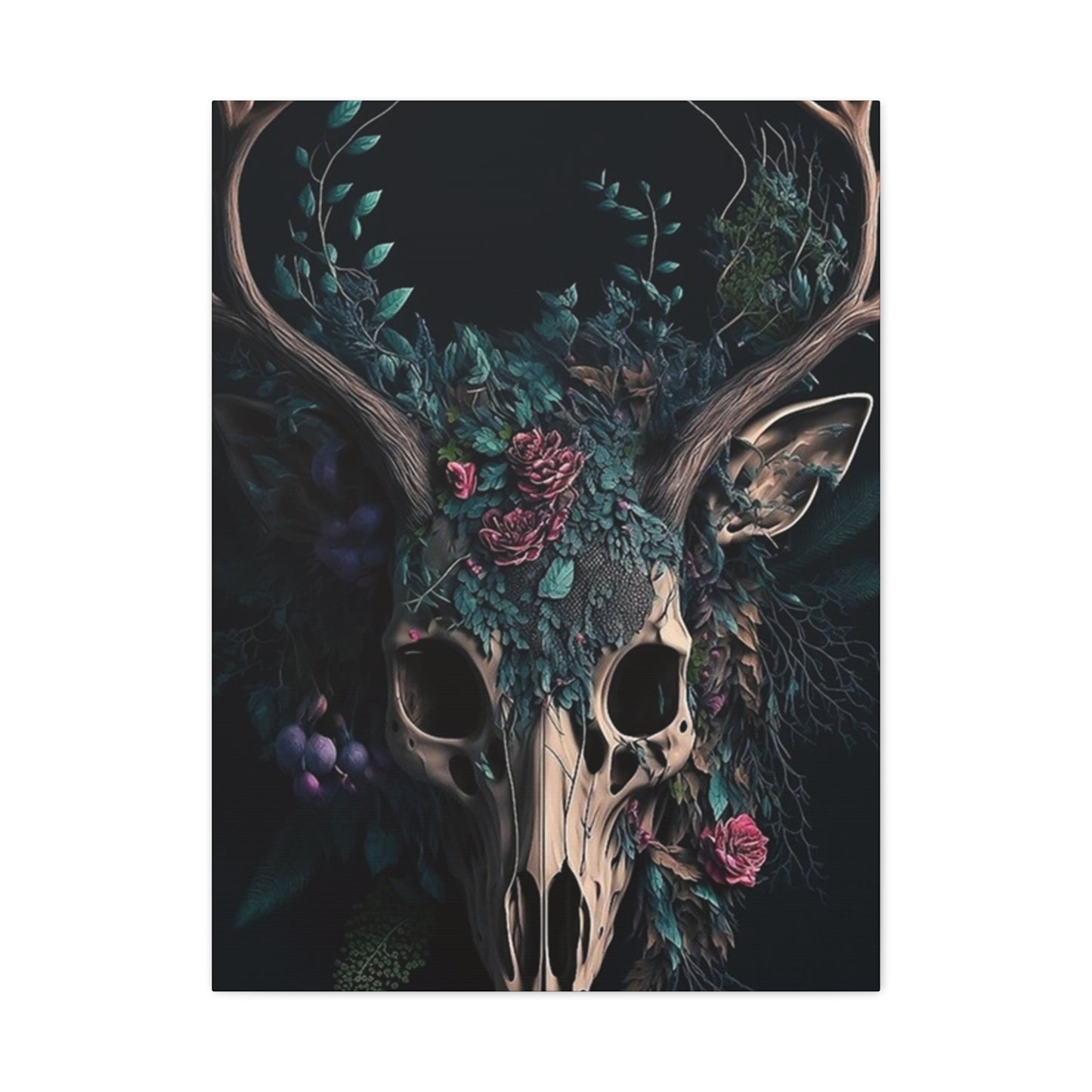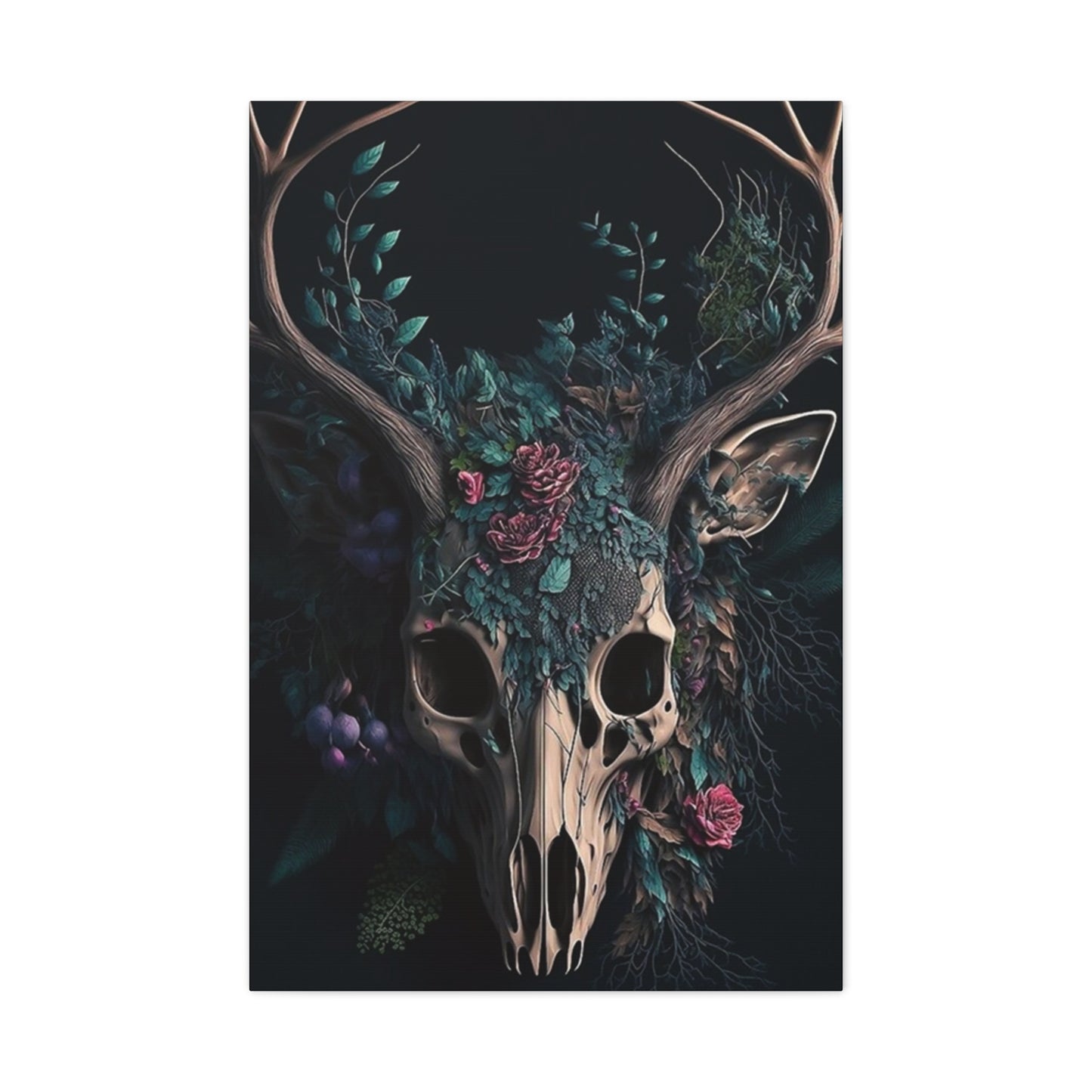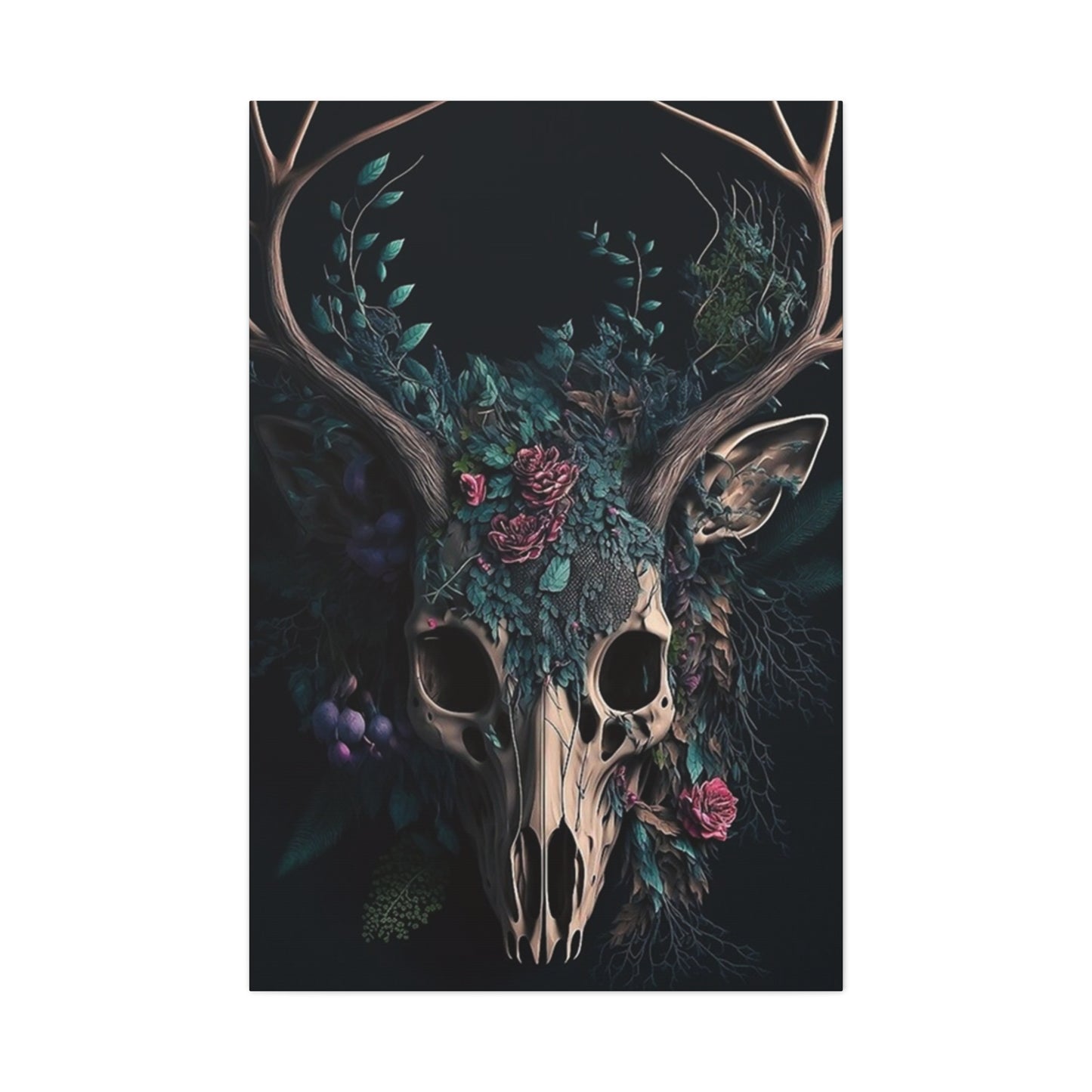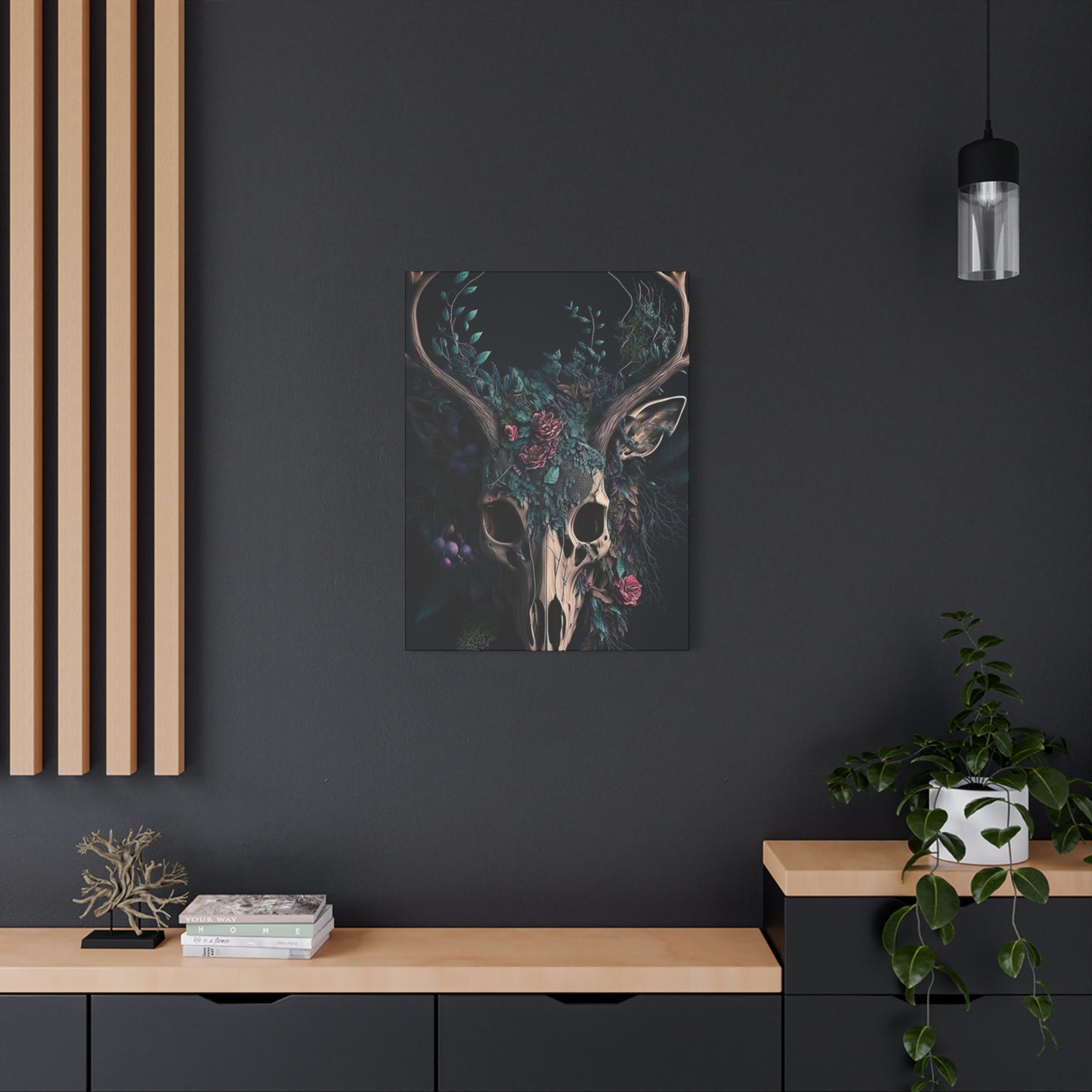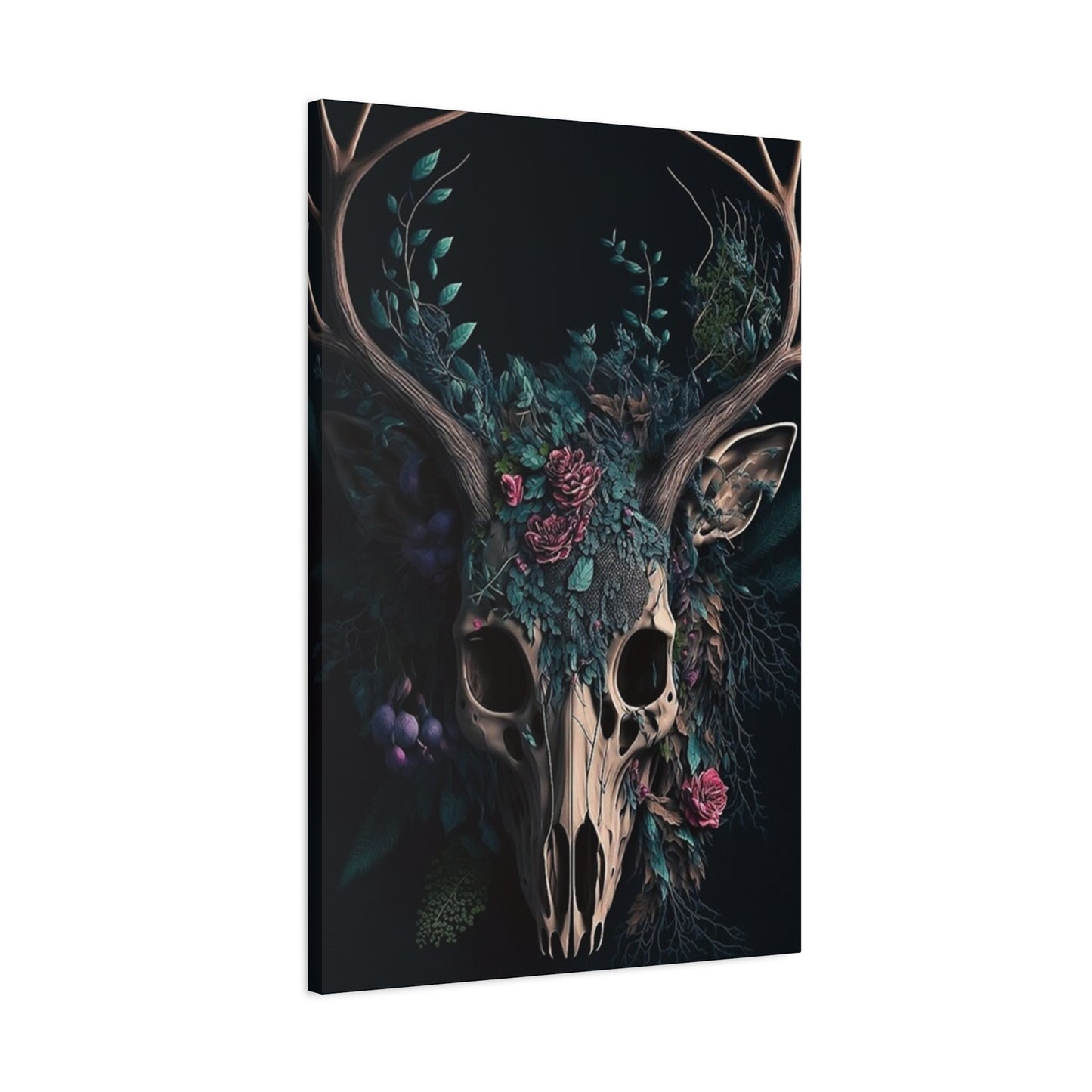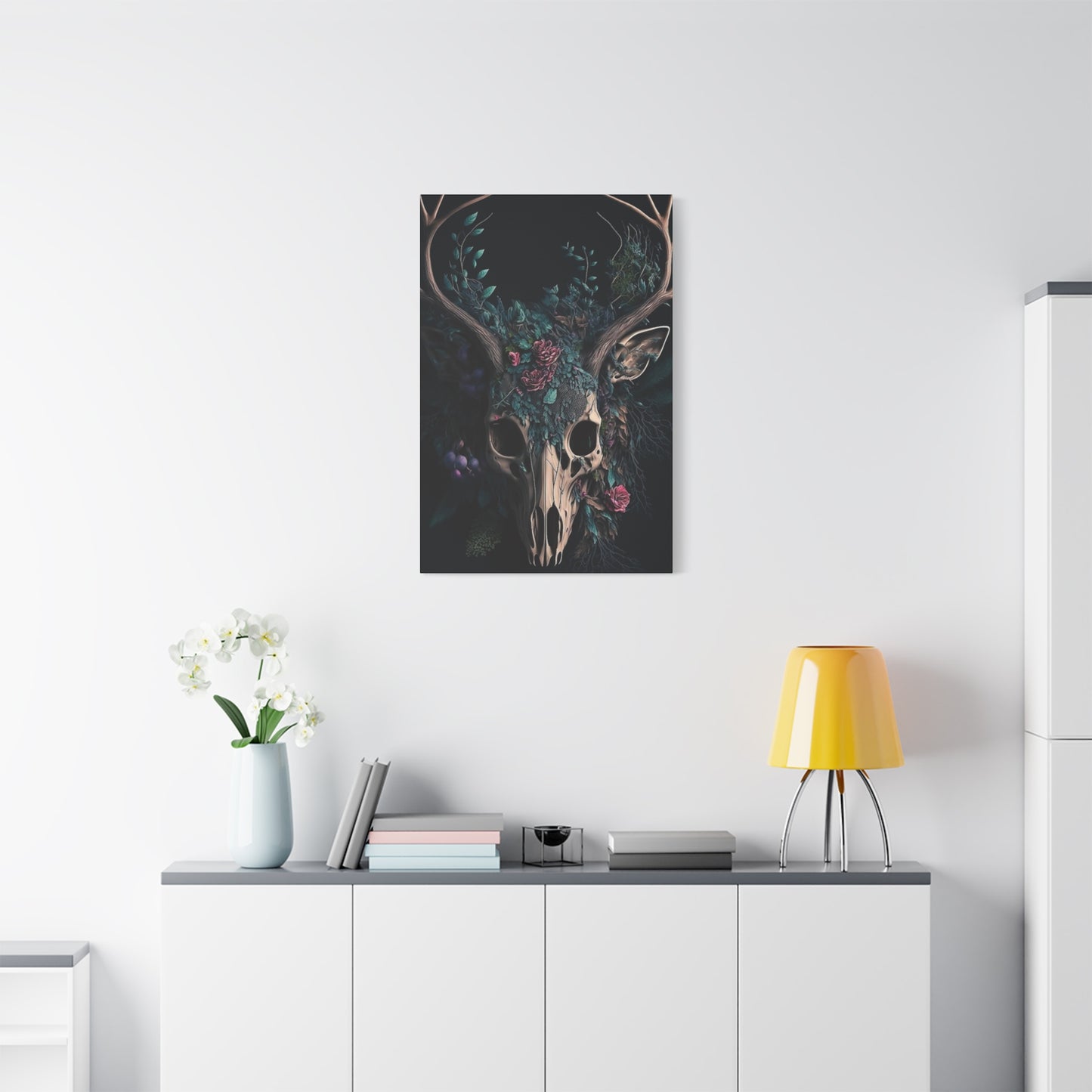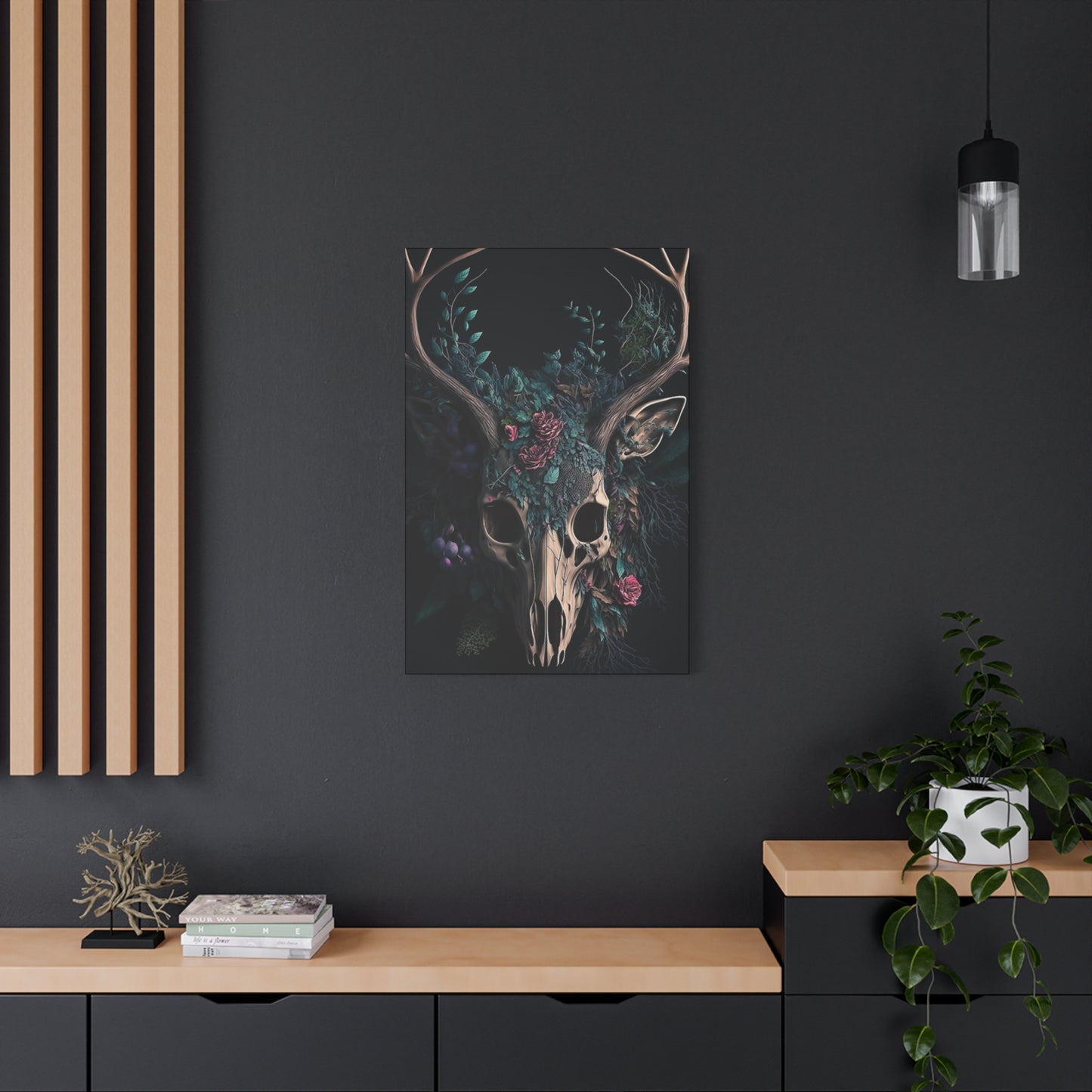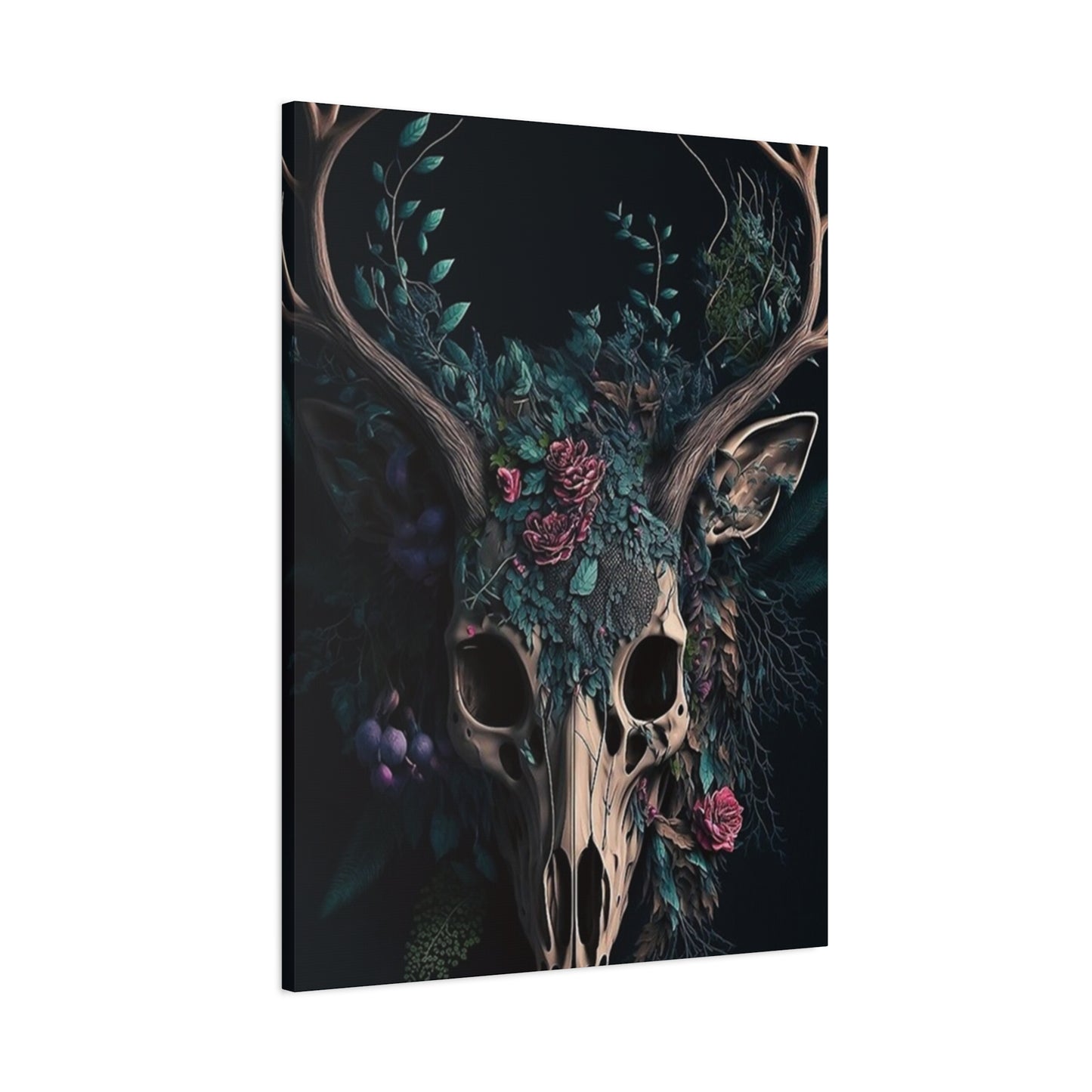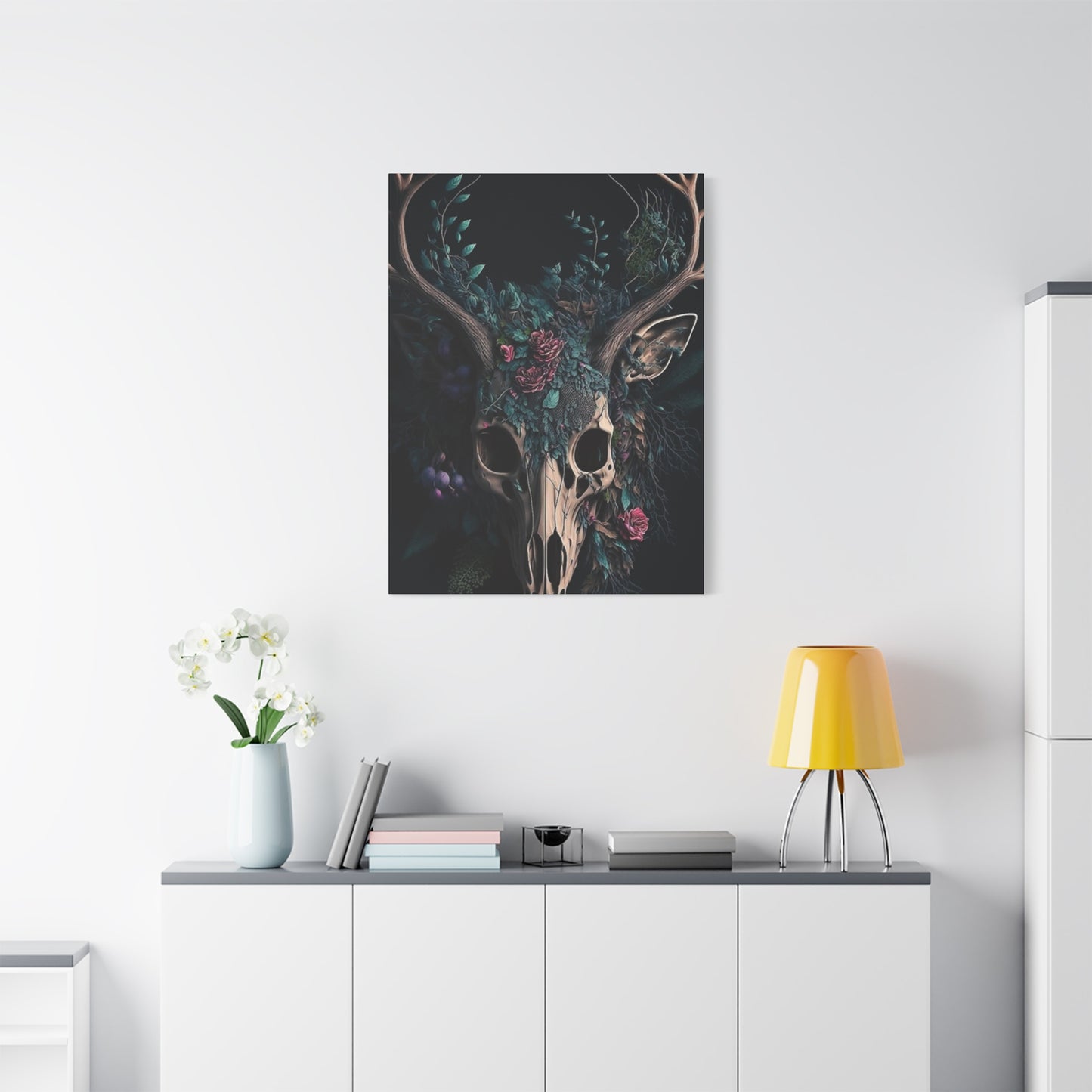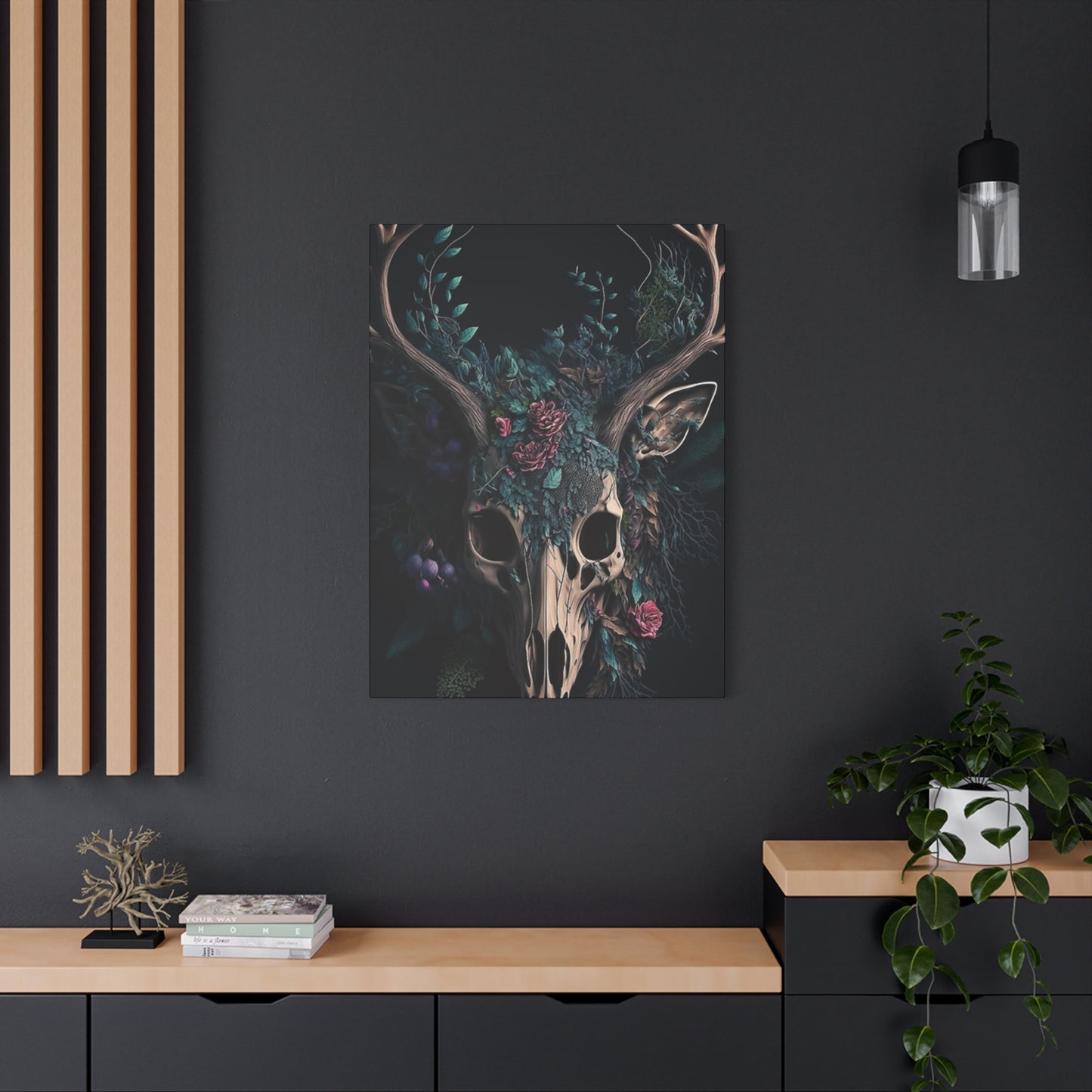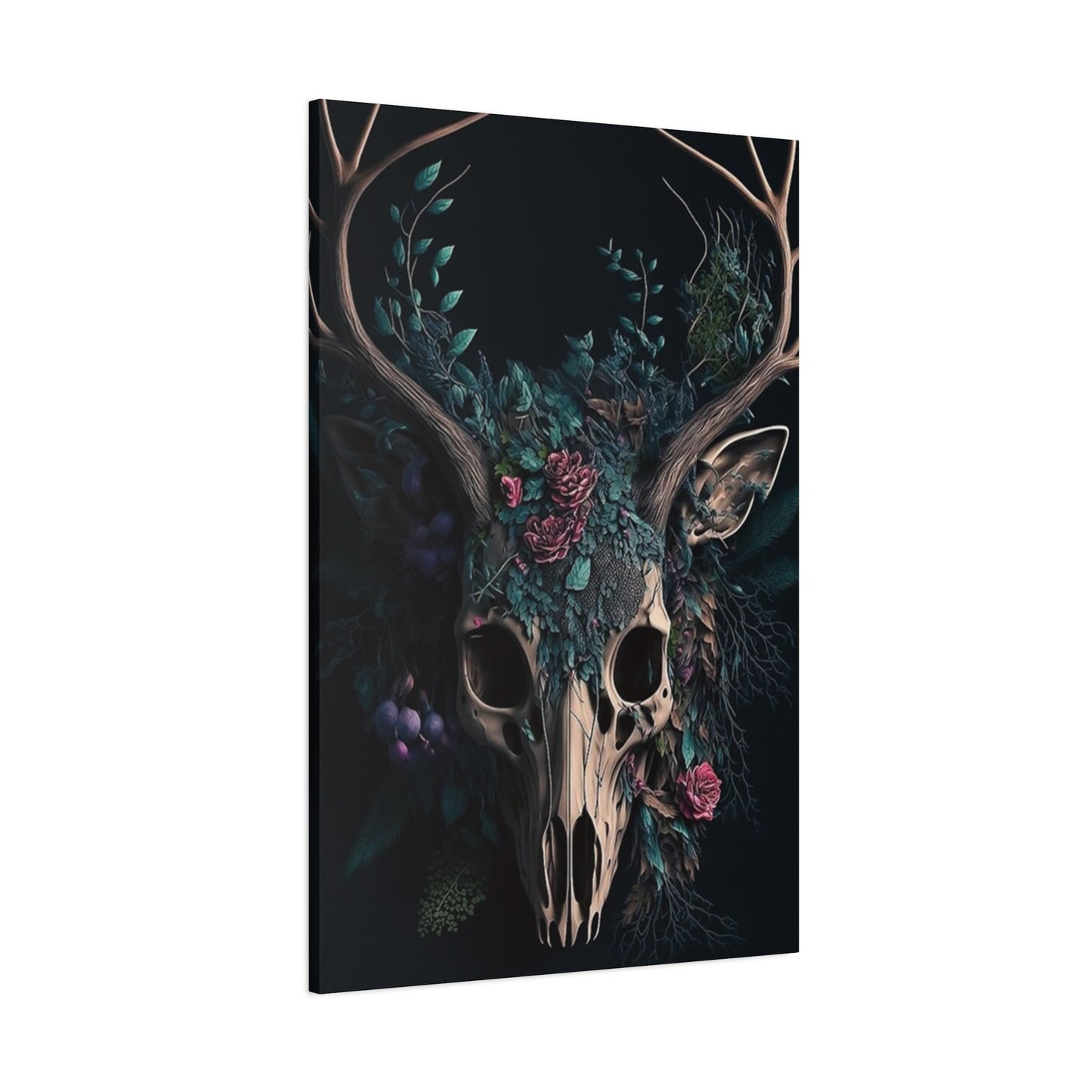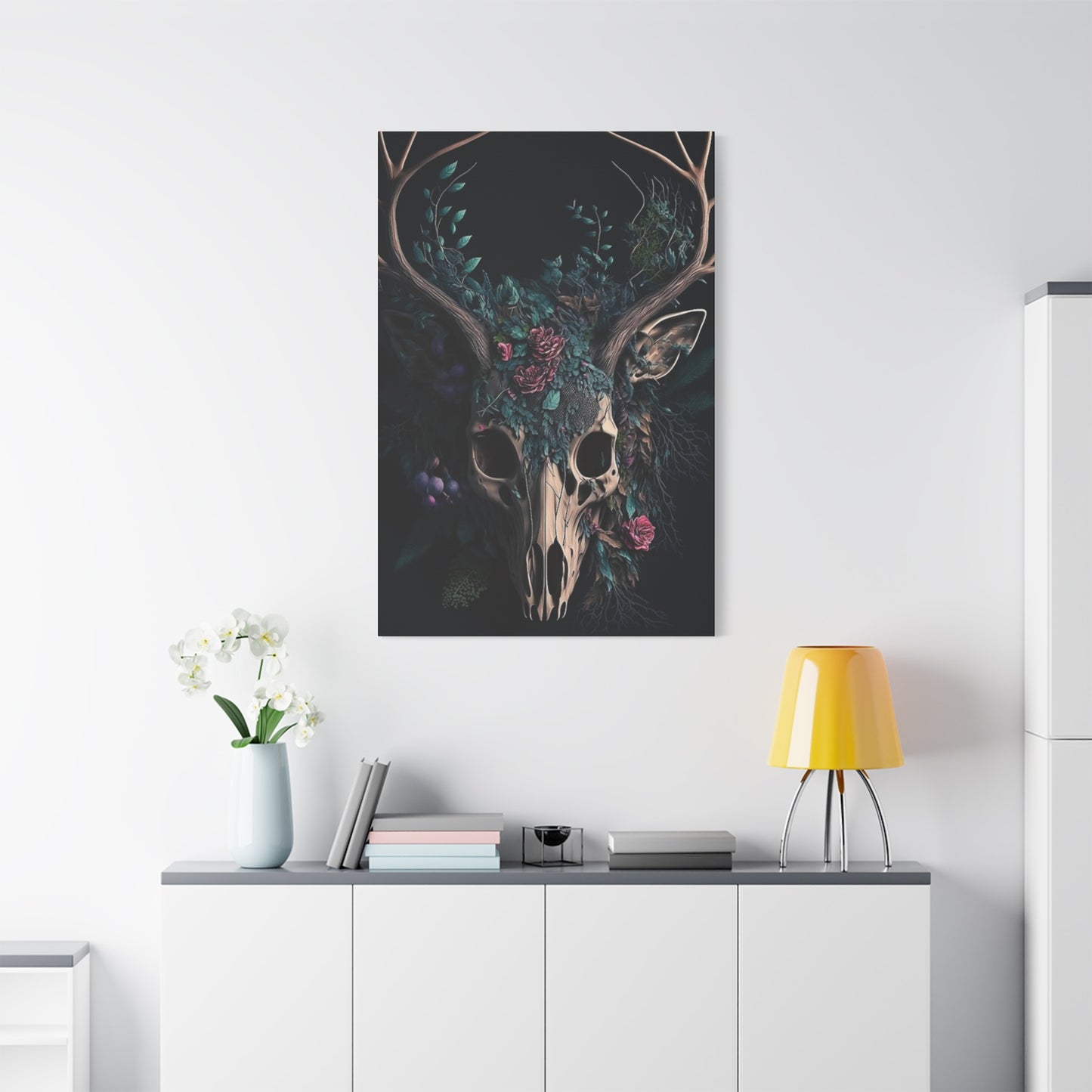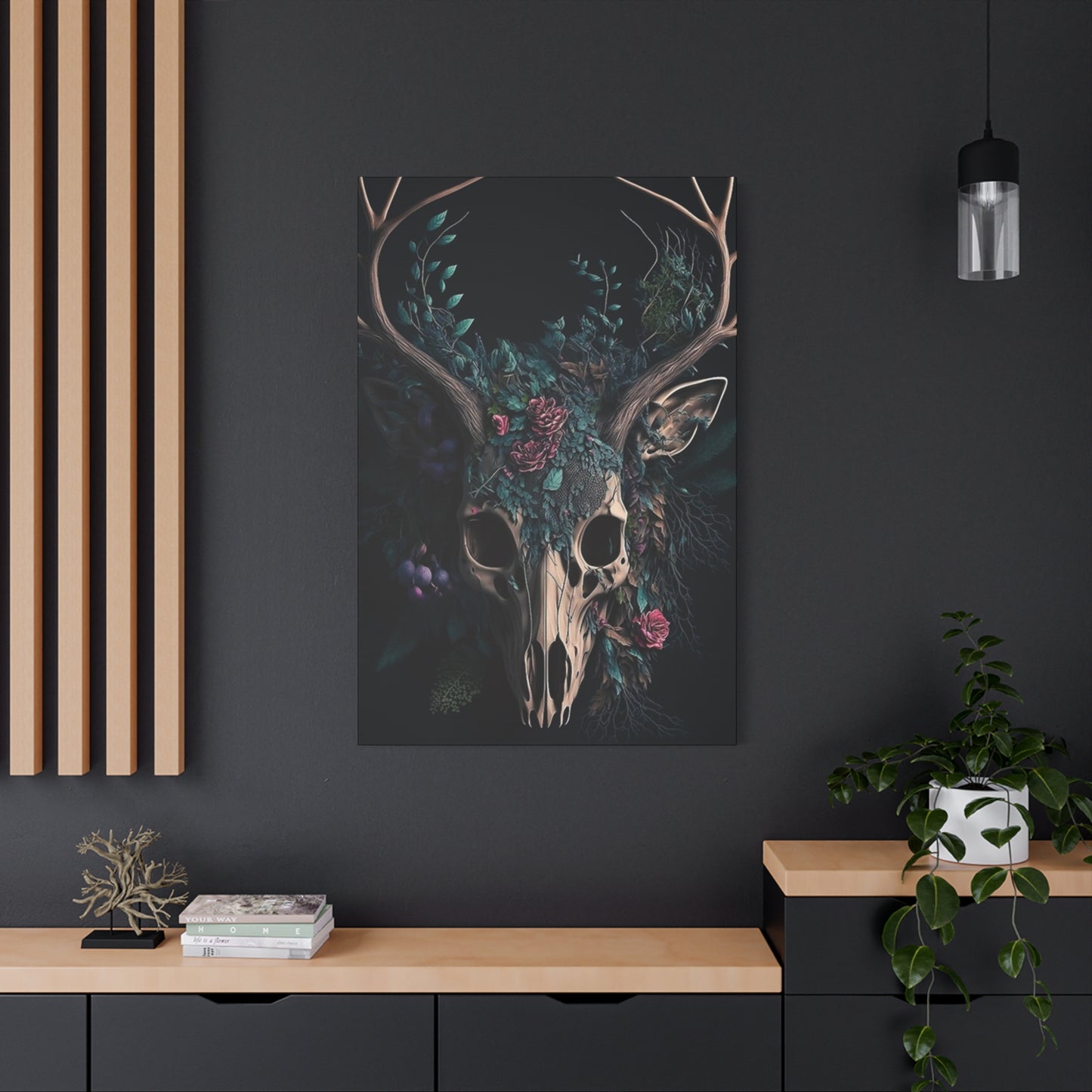Mystical Forest Vibes: The Spiritual Energy of Reindeer Skull Wall Art
The fascination with reindeer skull imagery has grown tremendously in recent years, becoming a cornerstone of contemporary interior design trends. This unique form of decorative art combines elements of natural history, Nordic mythology, and minimalist aesthetics to create striking visual statements in residential and commercial spaces. The reindeer skull poster has emerged as a powerful symbol that bridges the gap between rustic charm and sophisticated modern design sensibilities.
The appeal of these distinctive pieces lies in their ability to evoke multiple emotions and design philosophies simultaneously. When you incorporate a reindeer skull canvas print into your living space, you are not simply adding another decorative element. Instead, you are introducing a conversation piece that speaks to themes of nature, mortality, beauty, and the cycle of life. These artworks carry with them centuries of cultural significance from Scandinavian and Arctic regions, where reindeer have played crucial roles in survival, mythology, and daily life.
Interior designers and homeowners alike have discovered that these pieces possess a remarkable versatility. Whether your aesthetic leans toward industrial loft spaces, cozy cabin retreats, minimalist Scandinavian interiors, or eclectic bohemian environments, there exists a reindeer skull art piece that can complement and enhance your existing decor. The stark beauty of antlers set against carefully chosen backgrounds creates focal points that draw the eye without overwhelming the senses.
The growing popularity of these artworks reflects broader trends in contemporary design that value authenticity, connection to nature, and meaningful symbolism. In an increasingly digital world, people seek tangible connections to the natural environment. A carefully selected reindeer skull poster serves as a daily reminder of the wild spaces that still exist beyond our urban environments, bringing a piece of that wilderness into our personal sanctuaries.
The Historical and Cultural Significance Behind Reindeer Skull Imagery
The reindeer holds a special place in the cultural heritage of numerous indigenous peoples throughout the Arctic and sub-Arctic regions. For the Sami people of northern Scandinavia, the Nenets of Russia, and various other circumpolar groups, reindeer have been essential to survival for thousands of years. These animals provided food, clothing, transportation, and materials for shelter, making them central to both practical life and spiritual belief systems.
In traditional practices, the skull and antlers of the reindeer were never simply discarded after the animal's death. Instead, these remains were treated with great respect, often used in ceremonial contexts or as functional items. Antlers became tools, weapons, and ornamental objects, while skulls sometimes served as vessels for offerings or markers of sacred spaces. This reverence for the complete animal, including its skeletal remains, demonstrates a worldview that recognized the interconnectedness of all living things and the cyclical nature of existence.
Nordic mythology further enriches the symbolism surrounding reindeer. In these ancient belief systems, deer and reindeer were associated with various deities and supernatural beings. They appeared in stories as guides between worlds, as mounts for gods and goddesses, and as symbols of the wild forces of nature that humans must respect and understand. The antlers, in particular, were seen as representations of the tree of life, with their branching structure mirroring the cosmic tree that connected different realms of existence.
During the medieval and Renaissance periods in Europe, deer and elk skulls became popular subjects in vanitas paintings and memento mori art. These artistic traditions used skulls and other symbols of mortality to remind viewers of life's transience and the importance of living virtuously. While reindeer were less common in these southern European traditions, the broader category of cervid skull imagery established patterns that would later influence modern interpretations of reindeer skull art.
Contemporary artists who create reindeer skull posters draw upon this rich tapestry of historical and cultural meanings. Some emphasize the mystical and spiritual aspects, creating ethereal compositions that suggest otherworldly connections. Others focus on the stark beauty of the bone structure itself, treating the skull as a study in form, texture, and natural geometry. Still others incorporate elements of traditional indigenous art, paying homage to the cultures that first recognized the profound significance of these animals.
Understanding this background enriches the experience of displaying reindeer skull artwork in your home. Each piece carries echoes of these ancient traditions and beliefs, adding layers of meaning that transcend simple decoration. When guests admire your carefully chosen canvas print, you can share stories of Arctic peoples, Norse myths, or the artistic movements that have shaped our modern appreciation for these striking images.
Exploring Different Artistic Styles of Reindeer Skull Canvas Prints
The world of reindeer skull wall art encompasses an impressive range of artistic interpretations, each offering distinct aesthetic qualities and emotional impacts. Understanding these various styles helps you select pieces that truly resonate with your personal taste and complement your interior design vision.
Photographic realism represents one popular approach to this subject matter. These prints feature high-resolution images of actual reindeer skulls, often photographed against carefully chosen backgrounds. The level of detail in these pieces can be extraordinary, capturing every texture of weathered bone, every subtle variation in color, and the precise geometry of antler formations. Some photographers prefer stark black backgrounds that make the skull appear to float in space, creating a dramatic and almost otherworldly effect. Others choose natural settings, positioning skulls among moss, stones, or forest floors to emphasize the connection between death and the ongoing cycles of nature.
Minimalist interpretations take a different approach, reducing the reindeer skull to its essential lines and forms. These designs often employ limited color palettes, sometimes working entirely in black and white or using subtle gradations of a single hue. The focus in minimalist pieces falls on composition, negative space, and the elegant curves of antlers against simple backgrounds. This style particularly appeals to those who appreciate clean, uncluttered aesthetics and the principle that less can indeed be more when it comes to impactful visual statements.
Watercolor renditions bring softness and fluidity to reindeer skull imagery. Artists working in this medium create pieces where colors blend and flow, where edges become suggestions rather than hard boundaries. Watercolor skull art often incorporates floral elements, with delicate blooms emerging from or surrounding the bone structure. This combination of symbols traditionally associated with death alongside symbols of life and renewal creates poignant juxtapositions that invite contemplation. The translucent quality of watercolors adds an ethereal dimension, making these pieces feel dreamlike and introspective.
Abstract and geometric interpretations deconstruct the reindeer skull into shapes, patterns, and color blocks. These bold designs might fragment the skull across the canvas, reassemble it in unexpected configurations, or overlay it with geometric patterns that create visual complexity. Sacred geometry enthusiasts particularly appreciate versions that incorporate circles, triangles, and other shapes believed to hold symbolic significance. These pieces often feature vibrant color schemes that pop against neutral walls, making them excellent choices for spaces that need energetic focal points.
Gothic and dark aesthetic treatments embrace the macabre beauty of skeletal imagery. These pieces often feature rich, moody color palettes dominated by deep blacks, blood reds, and metallic accents. Artists working in this style might add elements like ravens, moons, or mystical symbols to create compositions that feel both ancient and contemporary. This approach appeals to those drawn to alternative aesthetics, gothic subcultures, or simply the dramatic visual impact of darker artistic themes.
Vintage and retro styles apply the visual language of old botanical illustrations, Victorian taxidermy displays, or mid-century design to reindeer skull subjects. These pieces might feature distressed textures that mimic aged paper, typography that recalls old scientific publications, or color treatments that suggest faded photographs. The nostalgic quality of vintage-styled skull art creates an interesting tension between the timeless subject matter and the temporal markers of specific historical periods.
Contemporary mixed media approaches combine reindeer skull imagery with various other elements to create complex, layered compositions. These might include collage elements, digital manipulation, paint splatters, or combinations of photography with graphic design. The results can be surprising and innovative, pushing the boundaries of how we traditionally view this type of subject matter. These experimental pieces often become true conversation starters, rewarding extended viewing with new details and interpretations.
Selecting the Perfect Size for Your Reindeer Skull Wall Art
Choosing the appropriate dimensions for your reindeer skull poster significantly impacts how the piece functions within your space. Size considerations extend beyond simple measurements to encompass concepts of proportion, visual weight, and the psychological effects of scale on room perception.
Large-scale pieces, typically ranging from three to six feet in width, create commanding focal points that immediately draw attention upon entering a room. These substantial artworks work particularly well in spaces with generous wall areas, such as above sofas, beds, or in dining rooms. When you select a large reindeer skull canvas print, you are making a bold statement about your design confidence and your appreciation for this particular aesthetic. The increased size allows for greater detail visibility, making textures and subtle color variations more apparent from across the room.
One key principle for large art placement suggests that the piece should occupy approximately two-thirds to three-quarters of the available wall space or furniture width beneath it. For instance, if you plan to hang your artwork above an eight-foot sofa, selecting a piece between five and six feet wide creates pleasing proportions. The skull imagery, with its horizontal antler spread, naturally lends itself to landscape orientations that complement standard furniture arrangements.
Medium-sized prints, roughly between two and four feet in their longest dimension, offer versatility that makes them suitable for various locations throughout your home. These dimensions work beautifully in bedroom settings, home offices, entryways, and as components of gallery wall arrangements. A medium-sized reindeer skull artwork provides sufficient presence to stand alone while remaining flexible enough to coordinate with other decorative elements without competing for visual dominance.
When working with medium pieces, consider the viewing distance from typical seating or standing positions in the room. Art that will be viewed primarily from six to ten feet away can handle more detail and complexity than pieces viewed up close. Conversely, artwork in intimate spaces like powder rooms or reading nooks benefits from simpler compositions that remain impactful even when observed from just a few feet away.
Small-scale skull prints, generally under two feet in any dimension, excel in creating clusters, collections, or accent points within larger design schemes. These compact pieces allow you to introduce the reindeer skull motif without overwhelming smaller rooms or spaces already rich with visual interest. Consider using small prints in groups of three, five, or seven to create dynamic arrangements that carry more visual weight than any single small piece could achieve alone.
The vertical versus horizontal orientation choice also deserves careful consideration. While reindeer skulls naturally suggest horizontal formats due to their antler spread, portrait-oriented compositions focusing on frontal views or emphasizing vertical antler tines offer interesting alternatives. Vertical pieces help draw the eye upward, making ceilings feel higher and adding a sense of elevation to your space. This orientation particularly suits narrow wall sections, spaces beside doorways, or arrangements where you want to create upward visual movement.
Multi-panel and triptych formats present another dimension in size selection. These pieces divide a single image across two, three, or more separate canvases, creating gaps that add rhythm and movement to the composition. A reindeer skull split across three panels, for example, creates a modern, gallery-like appearance while potentially spanning a larger total width than you might choose for a single unbroken canvas. The separation between panels adds visual interest and can help the artwork integrate more smoothly into contemporary interior schemes.
Scale psychology also plays a role in size selection. Oversized art in a smaller room creates a sense of intimacy and envelopment, making the space feel more like a curated personal gallery. Conversely, appropriately sized pieces in large rooms prevent the space from feeling cold or impersonal. Your reindeer skull artwork should feel intentional and considered rather than arbitrary or mismatched to its environment.
Color Palette Considerations for Reindeer Skull Decor
The color scheme of your chosen reindeer skull canvas print profoundly influences how the piece integrates with your existing decor and affects the mood of your space. Understanding color theory and the psychological impacts of different hues helps you make selections that enhance rather than clash with your interior environment.
Monochromatic schemes utilizing blacks, whites, and grays represent classic choices for skull artwork. These neutral palettes offer timeless appeal and extraordinary versatility, complementing virtually any color scheme in your existing decor. A black and white reindeer skull print brings crisp contrast and clean sophistication to your walls. The starkness emphasizes form and structure, allowing the natural beauty of the bone architecture and antler curves to take center stage without color distraction.
Pure white or cream-toned skull prints against darker backgrounds create luminous effects that seem almost spiritual. These pieces work exceptionally well in spaces dominated by wood tones or darker paint colors, providing bright focal points that prevent the room from feeling too heavy or closed-in. The lightness of bone against darkness also carries symbolic weight, suggesting themes of illumination, clarity, and the persistence of essential forms beyond superficial appearances.
Earth tone palettes incorporating browns, tans, ochres, and muted greens connect reindeer skull art directly to natural environments. These organic color schemes feel grounded and calming, making them excellent choices for bedrooms, meditation spaces, or any room where you want to foster feelings of tranquility and connection to nature. Warm browns and tans particularly complement rustic, farmhouse, or cabin-inspired interiors, reinforcing themes of wilderness and outdoor living.
Cool tone collections featuring blues, greens, and purples in various saturations create entirely different emotional landscapes. A reindeer skull rendered in icy blues and silvery whites evokes Arctic environments and the crystalline beauty of frozen landscapes. These cooler palettes work beautifully in contemporary and minimalist settings, adding visual interest without warmth that might conflict with deliberately austere design schemes. Deep navy or midnight blue backgrounds create sophisticated, moody atmospheres that feel both elegant and slightly mysterious.
Warm accent colors like rust, terracotta, burgundy, or gold introduce richness and visual warmth to skull imagery. These hues reference autumn landscapes, sunset skies, and the patina of aged materials. A reindeer skull print with warm metallic accents can add luxurious touches to spaces decorated in jewel tones or rich, saturated colors. Gold or copper highlighting on antlers catches light and creates subtle shimmer effects that add dimension and interest from multiple viewing angles.
Bold and vibrant color treatments represent more adventurous choices that make powerful statements. Imagine a reindeer skull rendered in electric blues, vivid magentas, or neon greens against contrasting backgrounds. These eye-catching pieces appeal to those with eclectic tastes or spaces already embracing bold color choices. Vibrant skull art works particularly well in creative spaces like studios, home offices for creative professionals, or entertainment areas where energy and personality take precedence over calm restraint.
Pastel interpretations offer softer alternatives that maintain visual interest without overwhelming gentler design schemes. Reindeer skull prints in dusty pinks, soft lavenders, pale mints, or peachy hues bring unexpected sweetness to traditionally stark imagery. This combination of gentle colors with more edgy subject matter creates intriguing contrasts that feel both modern and accessible. Pastel skull art works beautifully in spaces with shabby chic, cottage, or feminine bohemian aesthetics.
Considering your wall color forms an essential part of color palette selection. The relationship between your artwork and its background dramatically affects overall impact. High contrast combinations, such as dark artwork on light walls or vice versa, create bold, attention-grabbing effects. Lower contrast pairings produce more subtle, integrated looks where the art feels like an organic extension of the wall itself rather than a distinct object placed upon it.
The color of your furniture, textiles, and other decor elements should also inform your choice. Look for opportunities to either echo colors already present in your space, creating harmony and cohesion, or to introduce complementary colors that add visual excitement through strategic contrast. A reindeer skull print can serve as a bridge element, pulling together disparate colors in your furnishings through a thoughtfully chosen palette that references multiple existing hues.
Lighting conditions in your space significantly affect color perception. Natural daylight renders colors most accurately but changes throughout the day and across seasons. Rooms with abundant natural light can handle both light and dark artworks successfully. Spaces relying primarily on artificial lighting require more careful consideration, as warm-toned bulbs intensify warm colors while muting cool ones, and cool-toned lighting does the opposite. Consider viewing potential artwork choices in your actual space under your typical lighting conditions before making final decisions.
Material and Quality Factors in Canvas Print Selection
The physical properties of your reindeer skull wall art significantly impact its appearance, durability, and value. Understanding the various materials, printing techniques, and construction quality markers helps you invest in pieces that will maintain their beauty for years while providing the visual impact you desire.
Canvas material itself varies in composition and quality. Premium cotton canvas offers superior color absorption, durability, and archival properties compared to synthetic alternatives. The weave density, typically measured in grams per square meter, affects both the surface texture and the structural integrity of the finished print. Heavier canvases, generally ranging from 340 to 450 GSM, provide robust surfaces that resist sagging and maintain tautness over time. These substantial materials also better prevent print-through, where the texture of the weave becomes overly visible in the finished image.
Polyester and cotton-poly blend canvases present more budget-friendly alternatives that still deliver acceptable results for many applications. While these materials may not possess the same archival qualities as pure cotton, modern manufacturing techniques have improved their performance considerably. Blended materials often resist moisture better than pure cotton, making them potentially superior choices for bathrooms, kitchens, or other areas with higher humidity levels where your reindeer skull artwork might be exposed to dampening conditions.
The printing method dramatically influences color accuracy, detail resolution, and longevity. Giclée printing, considered the gold standard for fine art reproduction, uses specialized inkjet technology with multiple color cartridges to achieve exceptional color range and precision. These archival-quality prints, when properly executed on appropriate materials with pigment-based inks, can retain their vibrancy for decades without significant fading. When selecting a reindeer skull canvas print, inquire about whether giclée methods were employed, particularly if you are investing in higher-priced pieces.
Ink composition separates temporary displays from long-term investments. Pigment-based inks offer superior lightfastness and resistance to environmental degradation compared to dye-based alternatives. While dye inks may initially appear brighter and more saturated, they fade considerably faster, especially when exposed to direct sunlight or strong artificial lighting. For reindeer skull artwork intended as permanent additions to your decor, pigment-based printing is strongly recommended despite potentially higher initial costs.
The stretching and mounting process affects how your canvas presents on the wall. Gallery wrap construction, where the printed canvas continues around the sides of the stretcher bars, creates a finished appearance that requires no additional framing. The depth of these stretcher bars, commonly available in three-quarter inch, one and a half inch, or two-inch profiles, influences the shadow cast by the piece and how much it projects from the wall. Deeper stretchers create more dramatic shadow effects and lend greater physical presence to your artwork.
Corner construction quality deserves close examination. Professionally stretched canvases feature tight, clean corners without excess fabric bunching or gaps where the material fails to wrap smoothly. The canvas should be evenly tensioned across the entire surface, without waves, wrinkles, or loose areas. Wooden stretcher bars should be properly joined with no gaps or misalignments that might allow the frame to twist or warp over time.
Protective coatings add another layer of quality consideration. UV-resistant sprays or laminates shield your reindeer skull print from sun damage, helping preserve colors and prevent fading. Water-resistant treatments repel moisture, making the canvas easier to clean and less susceptible to damage from accidental spills or humidity. While these coatings add to production costs, they significantly extend the functional lifespan of your artwork, making them worthwhile investments for pieces you intend to display indefinitely.
Backing boards, while not always included, provide additional support and protection. These boards, attached to the reverse of the stretched canvas, prevent dust accumulation, protect against accidental punctures from behind, and add slight additional stability to the overall structure. For larger pieces, backing boards help prevent the canvas from flexing or sagging over time.
Edge printing, where the design continues onto the sides of the canvas, creates seamless appearances particularly important for gallery-wrapped presentations. Alternatively, some artists choose to mirror the edge design or employ solid colors on the sides. For reindeer skull artwork with dark backgrounds, solid black edges often create clean, professional looks. Lighter backgrounds might benefit from mirrored edges that maintain continuity around the entire visible surface.
Hardware quality affects both installation ease and security. Look for canvases that include properly secured hanging hardware, preferably with reinforced mounting points capable of supporting the weight without pulling through the canvas backing. Sawtooth hangers work well for smaller pieces, while wire systems with D-rings distribute weight more effectively for larger, heavier canvases.
Creating Gallery Walls Featuring Reindeer Skull Art
Gallery walls transform single decorative pieces into curated collections that tell visual stories and create dynamic focal points. Incorporating your reindeer skull canvas prints into thoughtfully arranged groupings amplifies their impact while allowing for creative expression that reflects your personal aesthetic journey.
The foundation of successful gallery wall design lies in establishing a coherent theme or visual thread that unifies disparate elements. Your reindeer skull artwork can serve as the anchor piece around which other items orbit, or it can integrate as one component within a broader nature, wildlife, or Nordic-themed collection. Consider including complementary subjects like forest landscapes, botanical illustrations, geometric patterns inspired by traditional Nordic design, or abstract pieces that echo the color palette of your skull print.
Scale variation adds visual interest and prevents monotony in multi-piece arrangements. Combine your large reindeer skull centerpiece with smaller supporting images in various sizes, creating a rhythm of visual weights that guides the eye around the entire composition. The largest piece typically serves as the anchor, positioned at or near the center or at eye level, with smaller pieces radiating outward or clustered asymmetrically around it. This size diversity creates dynamic tension that makes the arrangement feel curated and intentional rather than rigid or formulaic.
Spacing considerations significantly impact the overall cohesiveness of your gallery wall. Consistent gaps between pieces, typically ranging from two to four inches, create unified appearances where the collection reads as a single entity rather than random individual items. Tighter spacing produces more intimate, densely packed arrangements that feel energetic and abundant. Wider spacing allows each piece more breathing room, creating calmer, more contemplative presentations where individual works receive greater individual attention.
Layout planning before installation saves time and prevents wall damage from multiple holes. Create paper templates matching the dimensions of each piece, then arrange these on the floor or tape them to the wall, experimenting with different configurations until achieving a pleasing composition. Photograph various arrangements to compare options and gain perspective. Some designers recommend laying out the entire arrangement on the floor, then transferring measurements to the wall for precise placement.
Symmetrical arrangements provide formal, balanced appearances that suit traditional interiors or spaces where order and stability feel paramount. A grid layout with evenly sized pieces creates particularly clean, modern looks, while symmetrical arrangements of varying sizes require more careful planning to maintain visual balance. Your reindeer skull print might anchor the center of a symmetrical grouping, flanked by complementary pieces that mirror each other in size or subject matter.
Asymmetrical layouts offer more organic, dynamic alternatives that feel contemporary and personally expressive. These arrangements require more intuitive design sense, balancing visual weight through color, size, and placement rather than through mirror-image repetition. An asymmetrical gallery wall featuring your skull artwork might cluster several smaller pieces on one side of the anchor image, balanced by a single larger complementary piece on the other side, creating equilibrium through varied elements rather than identical ones.
Color coordination through matting, frames, or the artworks themselves helps unify gallery wall collections. If your reindeer skull print features predominantly cool tones, selecting supporting pieces that echo those colors or provide thoughtful warm contrasts creates visual conversations between the works. Alternatively, maintaining neutral frames throughout while allowing the artwork colors to vary creates cohesion through consistent presentation rather than color matching.
Thematic connections beyond pure visual similarity add narrative depth to gallery arrangements. Pair your reindeer skull canvas with pieces exploring related concepts like seasons, wilderness survival, Scandinavian folklore, natural cycles, or the relationship between humanity and wild spaces. These conceptual links engage viewers intellectually as well as visually, inviting contemplation about the meanings and messages behind your curated collection.
Mixed media gallery walls incorporate three-dimensional objects alongside flat artwork, adding textural interest and depth variation. Consider including actual antlers, preserved moss in shadow boxes, small sculptural elements, or shelves displaying natural objects like stones, pine cones, or carved wooden pieces. These dimensional additions transform your gallery wall from a simple picture arrangement into a more complete sensory experience that engages viewers from multiple angles.
Lighting enhances gallery wall impact dramatically. Picture lights mounted above individual pieces, track lighting directed at the arrangement, or even LED strip lighting behind canvases for halo effects all elevate the presentation. Proper illumination ensures your reindeer skull artwork displays to full advantage, with colors rendering accurately and details remaining visible even in otherwise dim rooms. Consider warm-toned lighting for cozy, intimate effects or cool-toned illumination for crisp, gallery-like precision.
Evolution and flexibility allow your gallery wall to grow and change over time. Leave intentional spaces where new acquisitions can integrate into the existing arrangement, or plan layouts that can accommodate seasonal rotations. Your reindeer skull print might remain a permanent fixture while supporting pieces change with your mood, the seasons, or your evolving aesthetic preferences. This approach keeps your decor dynamic and prevents visual stagnation.
Placement Strategies for Maximum Visual Impact
Strategic positioning of your reindeer skull wall art significantly influences its effectiveness as a design element. The location you choose affects not only how well the piece is viewed but also how it shapes the overall atmosphere and functionality of your space.
Living rooms present numerous possibilities for showcasing skull artwork. The wall above your sofa represents prime real estate in most layouts, offering generous dimensions and serving as a natural focal point visible from multiple seating positions. A large reindeer skull canvas print centered above the couch creates immediate impact upon entering the room, setting the tone for your interior aesthetic. Ensure adequate scale, with the artwork spanning approximately two-thirds of the furniture width beneath it for pleasing proportions.
Alternatively, consider featuring your reindeer skull art on the wall opposite your seating arrangement. This placement ensures the piece remains in view during conversation and relaxation rather than behind occupants. This position works particularly well in rooms with fireplaces or entertainment centers on the sofa wall, preventing competition between multiple focal points. The opposite wall often offers more flexibility in sizing since it is not constrained by furniture dimensions directly beneath it.
Bedroom applications of reindeer skull artwork require thoughtful consideration of the viewing context. Above-bed placement creates dramatic first impressions upon entering the room and provides contemplative imagery to observe before sleep and upon waking. Many find the natural themes inherent in skull art conducive to restful atmospheres, connecting the sleeping space to wilderness and natural cycles. However, personal comfort levels with skull imagery in intimate spaces vary considerably. Some individuals find skeletal subjects too intense for bedrooms, preferring gentler nature themes in these private areas.
For those who appreciate skull aesthetics but want softer bedroom approaches, consider positioning the piece on a wall adjacent to the bed rather than directly above the headboard. A dresser wall or seating area wall allows the artwork to contribute to the room's character without dominating the sleeping zone. This compromise provides aesthetic benefits without potential psychological intensity.
Home offices and creative workspaces benefit greatly from meaningful wall art that inspires and focuses the mind. A reindeer skull print behind your desk creates an impressive backdrop for video calls while providing thought-provoking imagery during work sessions. The natural and somewhat meditative quality of skull artwork can actually enhance concentration for many people, offering a fixed point for brief mental breaks that refresh focus without the distraction of screens or technology.
Dining areas offer excellent opportunities for conversation-starting artwork. Reindeer skull pieces above sideboards, buffets, or on feature walls adjacent to dining tables create sophisticated atmospheres that elevate everyday meals and special gatherings alike. The slightly unexpected nature of skull imagery in dining spaces can stimulate interesting conversations and reflect the host's confident design sensibility.
Entryways and hallways deserve special consideration as transitional spaces that shape first impressions. A striking reindeer skull canvas in an entry area immediately establishes your home's aesthetic character, welcoming guests while showcasing your design confidence. Hallways, often neglected in decorating schemes, transform into gallery-like passages when adorned with well-chosen artwork. The narrower dimensions of many hallways suit vertical skull orientations or smaller clustered arrangements.
Stairwell walls present unique opportunities and challenges for art placement. These often-prominent spaces display artwork from multiple viewing angles and distances as people ascend or descend. A reindeer skull print on a stairwell landing or along the angled wall paralleling the stairs creates visual interest in transitional spaces while making practical use of walls that might otherwise remain bare. Consider sight lines carefully, ensuring the piece displays attractively from both the bottom and top of the stairs as well as from various points along the journey between.
Height positioning follows general guidelines suggesting that the center of artwork should align with average eye level, typically ranging from 57 to 60 inches from the floor. However, this rule flexes based on ceiling height, furniture below the piece, and the viewing context. When hanging above furniture, generally leave 6 to 12 inches between the furniture top and the bottom edge of the artwork, creating clear visual separation without an awkward gap.
Corner placements utilize often-wasted space while creating surprising visual moments. A reindeer skull piece positioned in a corner, particularly when combined with complementary decor elements on adjacent walls, can transform dead zones into deliberate design features. This approach works especially well in rooms with challenging layouts where traditional center-wall placements might interfere with doorways, windows, or traffic flow.
Multi-room themes create cohesive design narratives throughout your home. If you are deeply drawn to reindeer skull aesthetic, consider incorporating related pieces in multiple rooms, each suited to the specific space's function and viewing context. This repetition with variation creates a signature style that makes your entire home feel intentionally designed rather than randomly decorated.
Seasonal rotation strategies keep your decor fresh while maximizing the utility of your art collection. Your reindeer skull artwork might take prominent position during autumn and winter months when its connection to cold climates and Nordic themes feels especially resonant, then rotate to a secondary location during warmer seasons when lighter, breezier pieces might take the spotlight. This approach allows you to enjoy multiple artworks throughout the year without overcrowding your walls simultaneously.
Complementary Decor Elements That Enhance Reindeer Skull Artwork
Creating harmonious environments around your reindeer skull canvas prints involves thoughtfully selecting furniture, textiles, accessories, and other design elements that reinforce and complement the aesthetic the artwork establishes. A cohesive approach transforms individual pieces into complete, immersive environments.
Furniture selections set the foundational tone for how your skull artwork integrates into your space. Natural wood furnishings, particularly those with visible grain patterns and rustic or reclaimed finishes, create obvious synergies with reindeer skull imagery. The organic textures and earth tones of wood pieces echo the natural world that skull art references, building thematic consistency throughout the room. Consider substantial wood pieces like live-edge tables, chunky wooden coffee tables, or exposed-beam ceilings that reinforce connections to forests, wilderness, and the natural materials from which our shelters originally derived.
Leather and hide upholstery options contribute additional textural richness that complements skull themes. Leather sofas and chairs bring warmth and tactile interest while referencing the animal kingdom in ways that harmonize with reindeer imagery. Distressed or aged leather finishes particularly suit the somewhat raw, unpolished aesthetic that skull art often embodies. Cowhide rugs or sheepskin throws add luxurious comfort while maintaining thematic relevance to wildlife and natural materials.
Metal accents in iron, bronze, copper, or blackened steel introduce industrial elements that surprisingly harmonize with organic skull art. The contrast between worked metal and natural bone creates visual tension that feels contemporary and intentional. Consider metal-framed furniture, industrial-style lighting fixtures, or decorative metal accessories that provide cool counterpoints to warmer organic elements. The combination prevents spaces from feeling overly rustic or theme-heavy while adding sophisticated edge.
Textile choices significantly influence how your reindeer skull print interacts with the broader room aesthetic. Natural fiber fabrics like linen, cotton, wool, and jute create textural variety while maintaining organic authenticity. Chunky knit throws, woven blankets, or fur accents add cozy comfort that balances the stark nature of skeletal imagery. These soft, touchable elements provide important contrast, preventing spaces from feeling too hard or cold despite edgier visual components.
Pattern selections should complement rather than compete with your skull artwork. Geometric patterns inspired by traditional Nordic and Native American designs create cultural connections that reinforce the heritage aspects of reindeer imagery. Herringbone, chevron, or simple stripe patterns add visual interest without overwhelming. Organic patterns like tree rings, topographical maps, or abstract representations of natural elements maintain thematic consistency while introducing variety.
Color palette extension from your artwork into furnishings and accessories creates unified environments. If your reindeer skull canvas features cool blue-gray tones, echoing those colors in throw pillows, curtains, or accent furniture pieces pulls the entire room together. Alternatively, choose accessories in complementary colors that create intentional contrast with the artwork, making both the piece and the accessories stand out more distinctly through strategic opposition.
Plant life introduces living organic elements that provide beautiful juxtapositions with imagery of death and remains. Large potted plants, hanging greenery, or arrangements of dried botanicals remind viewers of the continuous cycles of life, death, and renewal that skull imagery inherently references. Ferns, succulents, snake plants, or fiddle leaf figs all work beautifully in spaces featuring reindeer skull art, adding vitality and air-purifying benefits alongside aesthetic contributions.
Lighting fixtures deserve special consideration as they significantly impact both the artwork's visibility and the overall room atmosphere. Antler chandeliers or wall sconces create obvious thematic links while providing necessary illumination. If actual antler fixtures feel too literal or themed, consider fixtures with branching structures that echo antler forms more abstractly. Warm Edison bulbs create intimate, welcoming glows that soften the starkness of skull imagery, while cooler LED lighting maintains crisp, modern clarity.
Books and media displayed on coffee tables or shelves extend the intellectual and cultural dimensions of your reindeer skull aesthetic. Consider showcasing books about Scandinavian design, Arctic exploration, wildlife photography, natural history, or indigenous cultures. These curated selections demonstrate depth of interest beyond superficial decorating, suggesting genuine engagement with the themes your artwork represents.
Decorative objects like geodes, crystals, fossils, or mineral specimens create cabinet of curiosities atmospheres that suit skull imagery perfectly. These natural treasures share the skull's quality of being beautiful objects extracted from nature, things that reveal hidden structures and patterns not immediately visible in living contexts. Displaying such items in shadow boxes, on floating shelves, or under glass cloches adds layers of visual interest while maintaining thematic coherence.
Mirrors with interesting frames, particularly those featuring organic or geometric designs, interact dynamically with wall art by reflecting and fragmenting the imagery in unexpected ways. A well-placed mirror can also bounce light into darker corners while creating illusions of expanded space. Consider positioning mirrors at angles where they might partially reflect your reindeer skull artwork, creating intriguing doubled or fractured views.
Final thoughts:
Mystical Forest Vibes: The Spiritual Energy of Reindeer Skull Wall Art explores the profound interplay between nature, symbolism, and interior aesthetics. Reindeer skull artwork embodies both raw natural beauty and deep spiritual resonance, bridging the tangible world of wildlife with the intangible realm of meaning, ritual, and cultural significance. Displayed in living spaces, offices, or meditation areas, such wall art transforms ordinary walls into focal points of reflection, energy, and intrigue, allowing viewers to engage with themes of mortality, strength, and the enduring cycles of life.
At the heart of reindeer skull wall art is its striking visual and symbolic contrast. The skeletal form is simultaneously delicate and powerful, evoking the passage of time, the wisdom of nature, and the resilience of life in harsh environments. Artists accentuate the graceful curves of antlers, the intricate textures of bone, and the interplay of shadows and light, creating pieces that are visually commanding yet meditative. Whether rendered in hyper-realistic detail, abstract forms, or stylized interpretations, reindeer skull art captures attention, stimulates thought, and encourages contemplation of nature’s rhythm and power.
From an interior design perspective, this artwork offers remarkable versatility. The neutral tones of bone, antler, and natural textures complement modern minimalism, rustic cabins, bohemian interiors, and eclectic gallery spaces. Large-scale pieces create dramatic focal points, drawing viewers into the room and inviting a dialogue between the art and its surroundings. Smaller or multi-panel arrangements can establish thematic cohesion, allowing multiple perspectives of the skull or related forest motifs to narrate a spiritual and aesthetic story. Whether displayed above a mantel, within a gallery wall, or as a standalone centerpiece, the artwork enhances the sense of depth, intention, and personality in the space.
Lighting plays a critical role in enhancing the spiritual and visual impact of reindeer skull art. Soft, directional lighting highlights the textures and contours of the bone and antlers, casting subtle shadows that deepen the sense of mystery and dimensionality. Natural light enhances tonal variations and accentuates detail, while carefully positioned accent lights can emphasize focal points, creating a meditative atmosphere. Thoughtful illumination ensures the art becomes an immersive experience, allowing viewers to appreciate both its aesthetic and symbolic significance fully.
Beyond its visual appeal, reindeer skull wall art resonates emotionally and spiritually. Skulls have long symbolized cycles of life and death, wisdom, protection, and endurance, while antlers often signify strength, regeneration, and spiritual growth. Together, these elements evoke themes of resilience, transformation, and interconnectedness with the natural world. By bringing such imagery indoors, homeowners create spaces that encourage mindfulness, introspection, and a heightened awareness of both personal and universal cycles. This duality of beauty and symbolism makes the artwork profoundly compelling and uniquely suited for reflective spaces.
Artists employ diverse techniques to render reindeer skulls with impact. Detailed realistic paintings highlight every ridge, texture, and natural imperfection, offering tactile and visual authenticity. Minimalist line art, digital illustrations, or abstract interpretations focus on energy, flow, and emotional resonance, capturing the spiritual essence rather than literal representation. Mixed media approaches, combining paint, metal, or natural materials, further enhance dimensionality and intrigue, allowing each piece to evoke a sense of ceremony and reverence for the natural world.
Ultimately, Mystical Forest Vibes: The Spiritual Energy of Reindeer Skull Wall Art demonstrates that wall art can be far more than decorative—it can be transformative. These pieces bring together nature, culture, and spiritual symbolism to create interiors that feel both grounded and transcendent. They provide aesthetic impact while inviting reflection, conversation, and a deeper connection with natural and spiritual forces.
In essence, incorporating reindeer skull wall art into your space elevates design while honoring the power of the wild and the sacred. By carefully selecting, placing, and illuminating these works, homeowners transform walls into portals of spiritual energy, artistic expression, and meditative contemplation. Each piece becomes more than decoration; it becomes a dialogue between the natural world, human perception, and the cycles of life, offering both visual allure and profound resonance.

















